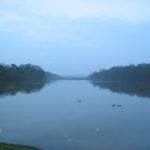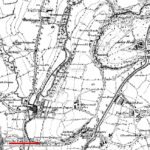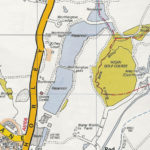



Construction of the Worthington Lakes Reservoir
The construction of the Worthington Lakes Reservoir in the 1850s played an important role in the lives of Henry Harold Harrison’s forebears. At that time Harold’s great-great grandparents, Henry Ball and Betty Ormishaw, occupied Heywood’s Farm on the east bank of the River Douglas adjacent to the site chosen for the new reservoir. Harold’s grandparents, Joseph Harrison and Ellen Ball, were probably also living at or near Heywood’s. In order to excavate the reservoir the Wigan municipal water authority needed to temporarily divert the river underneath the Ball’s farmland. They therefore purchased, through expropriation or other means, Heywood’s Farm.
The Balls and Harrisons moved up the road to Blundles Fold in Blackrod where Henry Ball again took up farming on a different piece of land. We know from birth records that they were living at Heywood in 1855 and at Blundles Fold in 1858 so the change of ownership of Heywood Farm and the family move occurred between those dates.
The construction of the tunnel itself, perhaps twenty metres down and a kilometre or so long, must have been quite a feat in an age where excavation was carried out by men with shovels and wheelbarrows!
The 19th century construction project is described on a display board that sits on the east bank of Worthington Lakes today. The following is a transcription of the information contained on the display board.
By the mid 1800s the population of the Wigan area had increased to 30,000 and a crisis arose with increasing demand for clean accessible water.
As a result, a civil engineer, Mr. Rawlinson was commissioned by the local Board of Health to inspect and survey the country around Wigan and report on options for a new water supply scheme. The water course chosen starting at Seven Stars Brook, flowing under Harrock Hall to the east of Parboid Range continued east into the River Douglas valley. This was chosen as a suitable site for the Worthington Reservoirs.
By 1858 the River Douglas was diverted through a tunnel to the east of the valley to enable work on two earth embankments and water treatment works to be started. The estimated cost for the works including diverted tunnel, treatment plant, 2 dams, mains and pumping station etc. was between £25,000 and £30,000.
Modifications to the site were needed due to a concern about flooding of mines along a geographical fault crossing the site and so another embankment was constructed (Adlington dam) along the fault line. The Douglas Tunnel had to be extended to give a greater capacity and Worthington Dam was created. An additional Act was required due to the extensive modifications at the site. In 1860 the Wigan Waterworks Act received Royal Assent and the works were then constructed. By 1867 the whole works were completed including connection to the distribution system of the Wigan areas.
The Arley and Worthington reservoirs had bypasses to enable them to be operated individually. When the reservoirs are low the earthenware pipeline along the side of the Arley reservoir and the cast iron pipeline along the Worthington reservoir are visible today.
The original treatment process was by slow sand filtration, flowing by gravity from the draw-off tower to the filter beds. The water was piped to a water tank at the foot of the dam and then to a second tank before flowing along a gravity trunk main down the Douglas Valley. The second tank can be seen today, a very long, low building with a pitched roof at the foot of the dam.
Worthington Reservoir when full is about 9 metres deep and has a capacity of 546 million litres. If required the water treatment works today could filter and chlorinate up to 8 million litres of water a day.
Today the Worthington Lakes, owned and operated by United Utilities, are part of a country park.
There are footpaths around the reservoir and across the major embankments between the sections of the reservoir. The footpaths are accessible from several locations off Chorley Road north of Red Rock Road, including an access path behind the Kilhey Court Hotel.
What was Heywood Farm is now called Water Works Farm. No farming is taking place there, probably in the interests of protecting Wigan’s water supply from agricultural runoff. There are a few houses on the site. The buildings that comprised Heywood’s Farm and Arrowsmith Farm are nowhere to be seen. Arley Hall, which once bordered Heywood’s Farm to the north, is now the Wigan Golf Club.